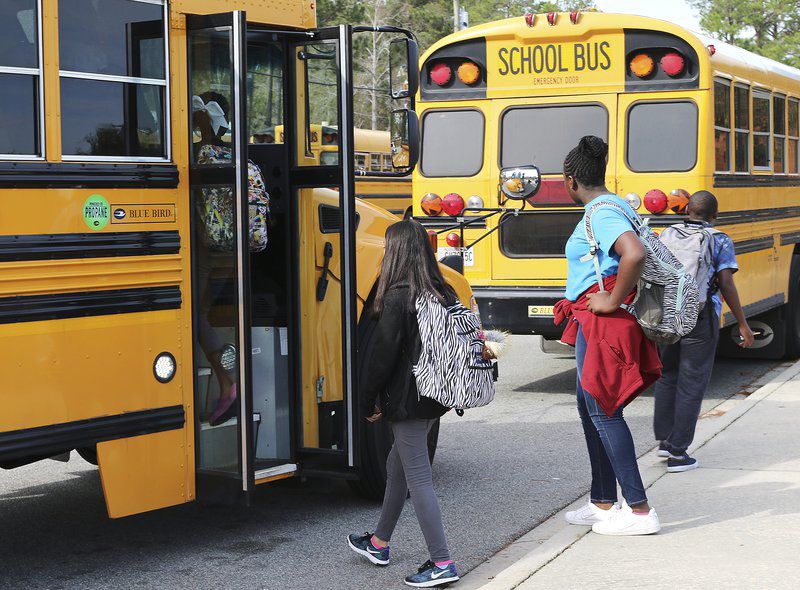Beyond the Numbers
Published 3:00 am Sunday, January 29, 2017

- Derrek Vaughn | The Valdosta Daily TimesState School Superintendent Richard Woods said while CCRPI scores show the work that needs to be done, it doesn’t reflect all the great things happening in schools across the state.
VALDOSTA — Franklin D. Roosevelt called education the “safeguard of democracy.” But who provides safeguards to ensure students are getting the best education possible and taxpayers are getting their money’s worth?
A massive education system is constantly being refined, melted down and reinvented by state and federal government.
Trending
The moving targets — state and federal benchmarks — make measuring school success tricky, and each state does it differently.
Georgia uses its College and Career Ready Performance Index to try to convey a full picture of a school’s performance. Florida focuses more heavily on student test scores.
School officials say it’s important to consider multiple factors that affect school performance, including poverty, home dynamics, teacher turnover and ever-changing state requirements.
School districts in the SunLight Project coverage area — Valdosta, Thomasville, Moultrie, Dalton, Tifton and Milledgeville, Ga., along with Live Oak, Jasper and Mayo, Fla., the surrounding counties and school systems across Georgia and North Florida — are constantly pushing to improve performance, especially since state assessments greatly impact a school’s reputation.
CCRPI: What It Is and Why It Matters
The CCRPI is Georgia’s accountability system for public schools. The Georgia Department of Education describes it as a “roadmap to improvement” that shows if schools are helping students achieve success.
Trending
It gives a whole picture of a school’s performance, said Matt Cardoza, chief communications officer for the Georgia DOE.
“(The score) matters because you want to know ultimately how your school is educating your child, if they’re doing that effectively,” Cardoza said.
CCRPI scores are calculated on a 100-point scale once a year for individual schools and entire school districts.
It answers many questions, the Georgia DOE says: “Are students achieving at college- and career-ready levels? Are students making academic progress? Are students prepared for what comes next?”
The score may be a single number but it is determined by an intricate web of categories and sub-categories. The numerous measurements take into account things such as test scores, student growth, graduation rates and special teaching strategies.
The score comes in four parts: Achievement, Progress, Achievement Gap and Challenge Points.
Achievement determines if students are performing at the right level.
Progress compares a student’s academic growth with others across the state.
Achievement Gap measures the difference between the lowest-performing students and the state average.
Challenge Points offers schools the chance to earn bonus points for “exceeding the bar” or for helping specific student groups meet established goals.
The statewide composite score for 2016 is 73.6, down from 75.5 in 2015. The drop came mostly from elementary schools. The Georgia DOE said the decline was caused by failure to meet goals for students who are poor or disabled, or who do not speak English fluently.
Because of the complexity of the scoring system, Cardoza said it’s important to not only look at the final number, but to also dig deeper to see what factors contributed to the score.
Each school faces unique challenges, and a low number doesn’t always equal bad teaching, he added.
“It’d be really difficult for me to say as a blanket statement (the score) means X because it’s not the same for any school,” Cardoza said. “There’s no school that’s exactly alike. That’s where school districts especially have to really dig in and find out what (the score) means.
“It can mean quality of teaching. It could mean something completely different. It could mean outside circumstances, more kids in poverty, and therefore more is required to help those students. There could be so many different things.”
Schools take the score seriously because it impacts public perception as well as goals for the school, Cardoza said.
A Moving Target
The CCRPI has been in Georgia since 2012. But the way the scores are calculated has changed every year since then except for the past two years.
The constant shifts in the scoring system have created a moving target that is difficult to figure out, many school officials said.
In South Georgia, teachers are burdened with unintended stress and fatigue as they try to adapt to a scoring method that is never the same for long, said Scarlet Brown, assistant superintendent of teaching and learning at Valdosta City Schools. Similar sentiments were expressed throughout the state and things are not much different in Florida.
The frequent changes can also make it hard for schools to measure yearly progress and to get an accurate picture of their current condition. Even if a school stayed exactly the same from year to year, its scores would rise and fall in that same time because of tweaks the state made to the complex CCRPI.
The score for Tift County Schools remained relatively steady from 2015 to 2016, dropping slightly from 73.7 in to 73.4.
Tift School Superintendent Patrick Atwater said he’s already expecting scores to drop lower next year — not because the school is declining, but because the scoring standards are shifting again.
“We expect next year for our elementary schools and middle schools to drop in scores because of the move away from testing science and social studies,” Atwater said. “Some of our stronger schools did exceptionally well in science and social studies last year and it really helped them on their achievement scores. They’re not going to get any credit for that next year.”
Atwater described the CCRPI as a “frustrating, data-driven giant” that is often difficult to understand.
“CCRPI does gather a lot of good data, it’s just that the data gathered is so comprehensive and it’s so complicated in the way that they calculate it that it’s very difficult to use it,” Atwater said. “In my 26 years in public education, I’ve never seen anything as complicated as CCRPI.”
The system is so complicated the school district had to hire a consultant to keep up with the constant changes.
That consultant, Bobby Smith, said he expects the CCRPI to keep changing as new legislation and policies trickle down from the state and federal level.
Cardoza admits that the CCRPI is not perfect.
“We know that it needs more than just test scores, but at the same time it is a very complex system. (It’s) sometimes hard for parents and even school district educators to really understand it, so we’re trying to simplify it some,” Cardoza said.
“CCRPI certainly has its flaws. I’m not saying it’s perfect but it’s the metric we have now that at least can help you take a look at certain areas of your school and also use it to see how schools in your area (are) performing.”
Dr. Dusty Kornegay, Thomas County Schools superintendent, is no fan of the CCRPI, partially because of the constant adjustments in the scoring formula. He also said online testing undermines the index’s credibility.
“Milestones” is the name of the test used to determine the academic measures of the CCRPI. The Georgia DOE has been pushing districts to give these tests online to reduce costs and expedite scoring.
Thomas County scored 70 in 2016 as compared to 76 in 2015. Kornegay blames online testing for the drop, saying younger students perform poorly on the test if they aren’t familiar with the device used to give the test.
“A careful internal analysis confirmed by a third party has found that almost all of the decline in our Milestones scores can be attributed to factors associated with online testing. The negative effects of online testing were most pronounced in elementary grades in students with disabilities and in math,” Kornegay said.
The Poverty Factor
The poverty level of a district also plays a big role in CCRPI scores, said Valdosta’s Scarlet Brown.
Valdosta schools scored a 65.9 in 2016, down from 71.4 in 2015. The district’s lowest-performing school was Newbern Middle School, which scored 56.3.
Most of Newbern’s students live in housing projects and come from at-risk environments, factors that make a big difference in scores, Brown said.
“If you look at the differences in scores that you’re going to see statewide, it unfortunately ends up sometimes being a reflection of the poverty levels of the district. I think you have to take that into account,” Brown said. “It doesn’t mean that they can’t learn. They can learn but the challenges are very different than a home where you may have two parents that are working in the home. They’re able to help with homework and provide extracurricular activities, versus a parent that may be holding down two or three jobs and may be a single parent in the home, male or female.
“We can’t deny the (different) dynamics. The school has a responsibility to do much more for that child. So we have significant challenges there. We’re very aware. We’re very concerned. We have a lot of work to do.”
Charter School Challenges
Charter schools are public-funded schools of choice, meaning they give parents and students another choice for education apart from the regular school districts.
Charter schools were scattered throughout the 2016 CCRPI scores. Many charters got some of the highest scores in the state. Others scraped the bottom of the barrel, earning 30s and 40s.
Scintilla Charter Academy, one of the newer charter schools in the state, scored 53.2; the school is not happy with the number, said Mandy Avera, Scintilla dean of students and school support.
“Obviously, we’re not pleased. But a first-year charter has unique experiences in trying to serve scholars from all different sorts of backgrounds.”
Scintilla opened in August 2015 and experienced a leadership change after only one semester.
Avera said the change and the newness of the school made a big impact on the score. She said charters have to build programs from scratch, programs that come cookie cutter in most public schools, programs the school didn’t have in its first year.
The score was also calculated from only 140 of the school’s 400 students, so it doesn’t represent Scintilla as a whole, Avera said.
Avera and her staff weren’t surprised by the score and they’ve already been working for months to improve the school by implementing a comprehensive academic program.
“(The score) is not indicative of where we feel like we are now, but we definitely are hard at work improving our scores,” Avera said.
“We’re building something different and we don’t like our children to be judged just on a test score but we want something that students deserve. That just doesn’t happen overnight.”
With new charter schools, Cardoza from the Georgia DOE said student performance is determined more by the schools where the children came from than by the charter itself.
The Failing Schools Problem
The Georgia DOE doesn’t label schools as failing, Cardoza said. But it doesn’t have to because Georgia’s government already did.
In 2016, Gov. Nathan Deal said schools scoring below 60 for at least three consecutive years should be considered failing and taken over by the state for the purpose of rehabilitation.
He put his idea into writing as Amendment 1 on the 2016 election ballot. School districts all across the state vehemently opposed it, saying it would wrongly take school control away from local leaders.
The amendment failed, but the problem of failing schools remains, state officials have said. How the problem will be fixed is unknown, but the CCRPI scores will most likely play a large role in determining which schools need to be fixed.
The scores for the entire Baldwin County School District went up in 2016. Each of the six public schools in the district saw some amount of improvement ranging from 0.3 points to as many as 13.4.
“The increases we have seen this year with the CCRPI report and our nearly 20 percent increase in the graduation rate have come from the incredible work of our teachers, students, administrators and parents,” Baldwin County Superintendent Dr. Noris Price said.
Blandy Hills Elementary’s remarkable increase from 49.4 in 2015 to 62.8 this year moved the school from the second-lowest performer in the district to third highest. Baldwin High School had the highest score locally at a 77.8, and outperformed the state’s 75.7 average for high schools.
Despite the improvement, Baldwin County still has three schools deemed as failing by the state’s measure: Eagle Ridge Elementary (54.1), Midway Elementary (56.6), and Oak Hill Middle (59.1).
Price said this year’s increases are just the start.
“We have been implementing innovative programs and changing the organizational culture of our schools. We are building a world-class educational system here in Baldwin County based on the fundamental principle that every child is capable of learning and we’re seeing that begin to pay off,” Price said.
Different State, Same Challenges
Florida has a different scoring system for its public schools, but it measures many of the same things, such as test scores and student progress. The state assigns a letter grade to each school and district.
Ted Roush, superintendent of Suwannee County Schools, said Florida’s education standards have changed just as often as Georgia’s.
“The frustration with school grades is that the state has changed almost on an annual basis the way in which those grades are administered to schools and what factors count in those components that eventually ends up as a school grade,” Roush said.
Suwannee County Schools earned a C in 2016.
Hamilton County Schools earned a D. Superintendent Rex Mitchell said the district has struggled to meet state standards ever since the inception of state testing.
“Some of the obstacles we face is when you live in a small, rural, low socioeconomic area, many families do not have the resources to supplement what the schools do,” Mitchell said. “Over the years, we have been doing what I call chasing the test scores.”
Mitchell said while he is dedicated to improving the grade, he is more concerned about preparing students for the next stage in life.
“I am trying to change the focus of the district from ‘What good test scores can we have?’ to ‘Can we make sure all of our students when they leave us are prepared for their future?’” Mitchell said.
“The tests are not going to become what drives us. The tests are going to become a part of the process that we go through.
“We know that school grades are very important, and we are obviously focused on having as high a school grade as possible. But our primary focus is going to be to ensure our students are in a position to be successful in the next part of their lives,” Mitchell continued.
“We feel like if we do a good job with that, that our test scores and our school grades will show the improvement.”
Lafayette County Schools earned a B in 2016. Superintendent Robby Edwards said it would be even higher if it weren’t for the new “learning gains” component the state added recently.
Learning gains measure if a student performs better or worse from year to year. Edwards said the new factor brought scores down across the state.
Edwards also believes schools shouldn’t be too invested in the state grades. But he did say they are a good indicator of how well a school is doing and how that school compares to the rest of the state.
“I don’t want to get too wrapped up around the numbers because it is not really about numbers or grades, but it is a way for us to look and be able to see how well we are doing for our students,” Edwards said.
Making it Work, Despite the Difficulties
Thomasville City Schools received scores of 60 or above for all of its schools except for one.
Harper Elementary’s 49.5 was the second year of a downward trend — decreasing from a 53.9 in 2015 and decreasing further from the 70.7 score in 2014.
Taking Harper’s reins in August — the third change in administration in three years — Principal Melvin Hugans said a score improvement plan was implemented his first month.
“Our goal is to focus on the area of literacy, which was an identified need from prior Georgia Milestone assessments,” Hugans said.
The literacy-centered plan includes close reading strategies and a heightened writing focus. Analyzing formative data is key, Hugans added. He said the data pinpoints student retention.
“Our initial results have shown our students are retaining a lot more information that teachers are covering in their classrooms,” Hugans said.
Despite the downward trend, Hugans said math is the strongest area of Harper’s score. With an improvement plan in place, Hugans equated accomplishing the plan to a team play-off scenario.
“Harper has the opportunity to show that this year, they can change the paradigm,” Hugans said. “That is our goal. We’ve had two years of scores that were below what the Georgia Department of Education expects, and those scores are not close to where the governor is asking all schools to be. Our goal is to this year, turn the trend. We need to show growth.”
Thomasville is not alone in its pinpoint focus on literacy.
Marni Kirkland, director of curriculum for Colquitt County Schools, said reading is the key that opens progress in all subject areas.
Colquitt scored 68.2 in 2016, a drop from the previous year’s 71.7.
“I think the biggest issue the district faces is in literacy,” Kirkland said. “All teachers have learned strategies to help students read better.”
The school system has focused on reading by using “interventions” that could be either tutored by system teachers or an outside instructor or with an online program. When students who have fallen behind catch up through the intervention, they move back to their regular schedule.
Valdosta has had a “laser-like” focus on literacy for years, Scarlet Brown said. Additionally, the district focuses on building support networks among teachers and solid relationships between teachers and students.
Dalton Public Schools Superintendent Jim Hawkins said he’s confident the system’s students are learning but he wants to ensure that is reflected in the CCRPI scores.
Dalton’s score climbed slightly from 66.1 in 2015 to 66.2 in 2016.
Hawkins said one of the keys to maintaining and improving the score is to focus on the Georgia Milestones tests, which are a key part of the CCRPI.
“At the district level, the thing that we have not done before is that we have tried to give teachers and students opportunities to practice on the test. The old test, the CRCT (Criterion-Referenced Competency Test) was generally multiple choice,” Hawkins said.
“Now, they have an extended response and a constructive response, which you have to write out. And a lot of it in our last administration was online. Our students were walking into this test and they’d never seen the extended response and a constructive response.”
This year, using Education Special Purpose Local Option Sales Tax (ESPLOST) funds, the Dalton district provided each student in third grade through high school a personal electronic device they can use in school and take home.
Hawkins said by using the device students can take practice tests online, getting comfortable with the process.
“And because they have their own device, when they do take the test, they are not going into a lab and taking the test on a computer they have never used before,” he said. “They are taking the test on their own device which they have been using for some time.”
Lowndes County Schools fared much better than other schools in the SunLight Project coverage area, scoring 82.2.
The district is proud of the student and teacher progress, said Rodney Green, assistant superintendent of teaching and learning. But he added district leaders are pushing to get the score higher there as well, and their strategy is a simple one.
“We provide teachers the support and resources they need to be successful. Our teachers, in return, set high expectations for student learning throughout the academic year,” Green said.
Lafayette County has the third highest graduation rate in the state with 93 percent. Robby Edwards said dual enrollment and tech courses play a big part in keeping that grad rate high.
“This seems to keep the hook in the kids to keep them motivated and moving forward with not only their career field but also their high school credits that they need to get their diploma,” Edwards said.
Suwannee County’s Ted Roush said focusing on early grades is the key to strengthening his district.
“In order for our system to get where we want to go academically, we have to be sure we get our K-3rd grade foundational skills as solid as can be,” Roush said.
Not Just a Number
State School Superintendent Richard Woods said while CCRPI scores show the work that needs to be done, it doesn’t reflect all the great things happening in schools across the state.
Scarlet Brown agrees. She once heard a speech by Phil Lanoue, the 2015 National Superintendent of the Year. One thing he said has always stuck with her: “No one would want to be just a number.”
Brown applied the sentiment to the numbers schools receive.
“You would never want someone to say ‘you’re an 82’ and that represents everything about you as an individual because really it’s hard to say that that one number is representative of everything that school is doing,” Brown said. “Of all the individuals, of all the children. It’s a very simplistic way of looking at a complex system.
“We have to be really careful that we don’t use that number to demoralize staff and students and parents. It doesn’t mean that we dismiss it. We don’t dismiss it. But it’s one piece of information in the bigger puzzle.”
The SunLight Project team of journalists who contributed to this report includes Charles Oliver, Billy Hobbs, Eve Guevara, Alan Mauldin and Patti Dozier, along with the writer, team leader John Stephen. Jordan Barela, Daniel DeMersseman and Jessie R. Box also contributed to the report.
To contact the team, email sunlightproject@gaflnews.com.





